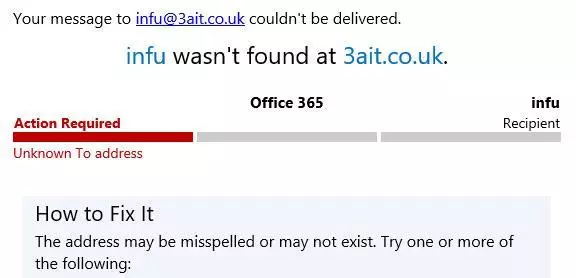We've all been there. You've just finished putting the finishing touches on a lengthy email, you hit the send button, and then you get a bounceback a few seconds later. Why has this happened?
9 times out of 10, the answer is "You've made a typo in the email address". However, this is by no means the only reason that a message might bounce back. Another common one is that the mailbox at the other end is full. Less frequent, but still worth mentioning is a rejection because the wording of your email has unintentionally triggered the spam filter at the other end. Whether it's one of these reasons, or something more obscure, the reason can be determined fairly easily by examining the bounceback that you have been sent.
Modern email systems like Office365 have made finding out why a message bounced very easy. The error you get back is usually very clear. For example:

You'll find this right at the top of the bounceback you receive. There's no doubting the problem in this case - the address doesn't exist.
However, as we all know, the bounceback you receive is often a lot more cryptic than this, and contains reams of seemingly inpenetrable technical information. Here's a standard example:
Delivery has failed to these recipients or groups:
A problem occurred while delivering your message to this email address. Try sending your message again. If the problem continues, please contact your email admin.
The following organization rejected your message: SERVERDiagnostic information for administrators:
Generating server: X
X
Remote Server returned '554 5.0.0 X #5.0.0 smtp; X - X This message has been rejected due to content judged to be spam by the internet community IB212 - If you feel this is in error, please submit a request using the following page X.>'Original message headers:
Return-Path: <>
Received: from X by X with emc1-ok (Exim 4.87)
(envelope-from <X>)
id X
for X; Mon, 27 Jun 2016 01:49:23 -0700
Received: by emcmailer; Mon, 27 Jun 2016 01:49:23 -0700
Received: from [X] (helo=X)
by X with esmtps (X)
(Exim 4.87)
(envelope-from <X>)
id X
for X; Mon, 27 Jun 2016 01:49:23 -0700
Received: from X (X) by
X X) with Microsoft
SMTP Server (TLS) id X; Mon, 27 Jun 2016 09:49:15 +0100
Received: from X ([X]) by
X ([X]) with mapi id
X; Mon, 27 Jun 2016 09:49:15 +0100
From: X <X>
To: "X" <X>
Subject: X
Thread-Topic: X
Thread-Index: X
Date: Mon, 27 Jun 2016 08:49:15 +0000
Message-ID: <X>
Accept-Language: en-GB, en-US
Content-Language: en-US
X-MS-Has-Attach:
X-MS-TNEF-Correlator:
x-originating-ip: [X]
Content-Type: text/plain
MIME-Version: 1.0
X-Outbound-IP: X
X-Env-From: X
X-PolicySMART: X
X-Virus-Status: Scanned by VirusSMART (c)
X-Virus-Status: Scanned by VirusSMART (s)
X-Exim-DSN-Information: Due to administrative limits only headers are returned
Understandably. most people's first reaction when they see a message like this is to either ignore it, or forward it to someone more technical. However, you can usually ignore about 97% of the message. What you're looking for is what the server at the other end has given as the reason for rejection. This has been highlighted in bold in the message above. In this case, the reason is pretty clear, as is the solution (the link to remedy has been removed in the example above).
Not all bouncebacks look identical to the one above. However, the principal remains the same. You just need to scroll down until you find "Server response" or "Server returned" or similar. This will be followed by the reason for rejection.
Sometimes the errors are not as clear as the one above. It's not unusual to see just a numerical code here. Notice the reason above starts with the code "554". In these cases, Google is your friend. If you Google "Email rejected 554", you'll get results explaining exactly what this code means.The most common code to see here is 550. This is exactly the code that would have been returned in the Office 365 example above. This means that the server at the other end thinks the address you've sent to doesn't exist.
Very occasionally, there may be times that you are none-the-wiser even after you've Googled the error code. There are a few reasons for bouncebacks that are very obscure. However, these are very few and far between. Hopefully, this HowTo will have helped you identify what you're looking for amongst the technical details when you get a bounceback.
